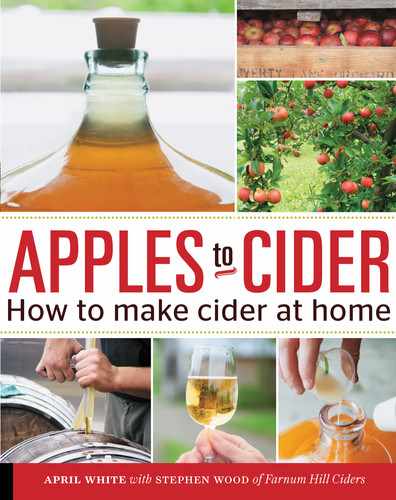Glossary
Some terms home cidermakers will encounter, as they apply to the cidermaking process:
Acetic fermentation: The process through which alcohol is converted into acetic acid, the distinctive component in vinegar. Acetic fermentation occurs when a strain of acetobacter bacteria is present and the cider is exposed to oxygen and moderate temperatures.
Airlock: A piece of the equipment used during the fermentation process to let carbon dioxide produced by the yeast escape from the carboy while preventing air from entering
Alcohol by Volume (ABV): A standard measure of alcohol in an alcoholic beverage, expressed as a percentage of total volume. Cider typically has an ABV of 5 percent to 12 percent.
Alcoholic fermentation: Process by which yeast converts sugars into alcohol and carbon dioxide
Apple brandy: A spirit distilled from cider, also known as Calvados. Apple brandy is distilled twice to 70 to 75 percent alcohol and barrel-aged.
Applejack: Another name for apple brandy or a moonshine produced by freezing and thawing hard cider to concentrate the alcohol
Apple wine: A fruit wine, in which sugar is added to apple juice before fermentation or to support a secondary fermentation to create a light-bodied beverage
Astringency: The drying sensation in the mouth associated with tannins in cider
Bittersharp apples: Cider apples high in both acid and tannins
Bittersweet apples: Cider apples low in acid and high in tannins
Body: The viscosity of a cider
Brix: A scale of measurement used to measure the sugar content of juice
Bung: A stopper used to seal a barrel or carboy; made of rubber, silicon or cork and available in solid and bored versions
Campden tablets: Tablets of potassium metabisulfite used to add sulfur dioxide to cider
Carboy: A jug with rigid sides and a narrow neck and mouth, ideal for fermenting cider
Cornelius keg: A steel cylinder with a removable lid designed to hold a liquid under pressure; ideal for adding carbonation to cider
Cyser: A meadlike drink in which honey is added to apple juice before fermentation
Disgorgement: The final step in the méthode champenoise cidermaking process in which expired yeast is removed from the bottle
Drop bright: The process through which sediment falls out of a cider, leaving a clearer liquid
Dry: A term for a cider that has been fully fermented, leaving no residual sugar
Farmhouse: A term originally used to describe the small-batch ciders produced by local farmers
Finish: The aftertaste of a cider
Flavored cider: A drink in which apple juice is fermented with the juice of another fruit, or flavored with additional fruit after fermentation
Hard cider: A drink made from fermented apple juice
Hydrogen sulfide: A sulfur compound that can, in excess, cause the unpleasant aroma of rotten eggs and compost in cider
Hydrometer: An instrument for measuring a cider’s specific gravity
Ice cider: A full-bodied after-dinner drink made from fermented apple juice with an 8 to 12 percent alcohol
Keeving: A cidermaking process in which pomace is left unpressed for several days stripping it of nitrogen and other nutrients that yeast need to thrive
Lees: The apple solids and expired yeast that collect on the bottom of a container of cider
Litmus paper: Acid-sensitive strips used to measure pH
Malic acid: The predominate acid in apples
Malolactic fermentation: The process through which lactobacillus and other bacteria convert malic acid to to lactic acid.
Maturation: A process of aging cider
Méthode champenoise: A method of cidermaking using a second, in-bottle fermentation to produce sparkling cider with delicate, persistent bubbles
Mousiness: A cider flaw caused by slow-developing strains of lactobacillus or brettanomyces bacteria. It is most frequently described as the aroma of mouse droppings.
Mouthfeel: The sensation of cider in the mouth
“New England” cider: A 7 to 13 percent alcohol drink, in which sugar, molasses, or maple syrup is added to apple juice before fermentation. Raisins are often also added.
Nose: The aromas of a cider
Oxidation: The effects of exposing cider to oxygen
pH: A measure of the strength of acid in a solution
Pitching: Adding yeast to apple juice
Pomace: The pulp of the apple after it is milled, used for pressing
Pommeau: A blend of apple brandy and sweet cider, aged in oak. About 16 to 18 percent alcohol
Proofing: The process of hydrating and feeding the yeast prior to introducing it in the cidermaking process
Rack: The process of moving cider off its lees during the cidermaking process
Residual sugar: The sugars left in a semisweet ciders made by halting the fermentation before the yeasts convert all of the sugars present to alcohol
Riddle: The process of rotating and reorienting bottles during méthode champenoise cider production to collect the lees in the neck
Semi-sweet: A description of a cider with noticeable residual sugar
Sharp apples: Cider apples that are high in acid and low in tannins
Sparkling: A description of a cider with noticeable dissolved carbon dioxide
Specific gravity: The measure of soluble solids in a liquid; used to determine a juice’s sugar content
Still: A description of cider with no or very slight effervescence
Sulfur dioxide: An additive that serves as an antimicrobial and antioxidant in cidermaking
Sweet apples: Cider apples that are low in acid and tannins, and add fruit flavors and aromas to cider
Sweet cider: The nonalcoholic fresh-pressed juice of the apple, sold for consumption
Tannin: A substance present in apples that provides the structure, astringency, and bitterness in cider
Volatile acidity: A term used to describe the presence of acetic acid in cider
Wine thief: A ridged, narrow tube with openings at both ends designed for extracting liquid from a container
Yeast: A single-cell fungus that converts sugars to alcohol
Yeast nutrients: An additive that can be used to provide yeast with a hospitable environment for alcoholic fermentation
